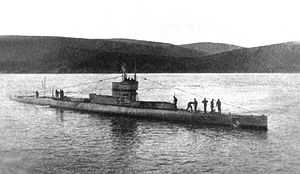British G-class submarine
 G class submarine. Photo: R N Submarine Museum, Gosport. | |
| Class overview | |
|---|---|
| Name: | G |
| Builders: | Chatham Dockyard, Armstrong Whitworth, Vickers, Scott's |
| Operators: |
|
| Completed: | 14 |
| Cancelled: | 1 |
| Lost: | 4 |
| Retired: | 10 |
| General characteristics | |
| Type: | submarine |
| Displacement: | Surfaced / Submerged: 703 tons / 837 tons |
| Length: | 57.5 m (189 ft) |
| Beam: | 6.92 m (22.7 ft) |
| Draught: | 4.15 m (13.6 ft) |
| Propulsion: | Twin-shaft, 2 × 800 bhp Vickers diesel, 2 × 840 shp electric motors |
| Speed: | Surfaced / Submerged: 14.5 knots (27 km/h) / 10.0 knots (19 km/h). |
| Range: | 44.14 tons of fuel oil giving 3,160 nm surfaced at 10 knots (19 km/h). 95 nm submerged, at 3 knots (6 km/h). |
| Complement: | 31 |
| Armament: | Torpedoes: 2 × 18" bow tubes, 2 × 18" beam tubes, 1 × 21" stern tube. 10 torpedoes in total. Guns: 1 × 3 inch 10 cwt. Mk.1 Elswick Quick Fire High Angle {QFHA}, forward. 1 × 12-pounder. 8 cwt. Mk. 1 gun HA mounting, aft. |
The Royal Navy's G-class of diesel/electric submarines were launched between 1914 and 1917, and intended for operations in the North Sea and German Bight in World War I against German U-boats. The design was based on the E-class, adopting the double hull concept, but in practice showed little improvement, the ships notoriously slow to dive.[1][2]
A total of 14 boats were built at four yards: G1 to G5 by Chatham Dockyard, G6 & G7 by Armstrong Whitworth, G8 to G13 by Vickers, and G14 by Scott's on the Clyde. G15 was ordered from Samuel White's yard at Cowes, Isle of Wight, but cancelled.[3] The class was distinguished by the 21-inch stern torpedo tube, an electric oven in the galley, and Fessenden Underwater Sound Telegraphy. The G-class had their bows raised during the war to increase buoyancy and improve seakeeping.
Boats
Fourteen of fifteen vessels ordered were completed:
- G1 - Launched 14 August 1915. Sold for scrap 1920.
- G2 - Launched 23 December 1915. Sank U-78 in the Skagerrak, 28 October 1918. Sold for scrap 1920.
- G3 - Launched 22 January 1916. Sold for scrap 1920.
- G4 - Launched 23 October 1915. Sold 1928.
- G5 - Launched 23 November 1915. Sold 1922.
- G6 - Launched 7 December 1915. Sold 1921.
- G7 - Launched 14 March 1916. Last British submarine lost in World War I, on or about 23 October 1918, cause unknown.
- G8 - Launched 1 May 1916. Lost in the North Sea for reasons unknown on or about 14 January 1918.
- G9 - Launched 15 June 1916. Sunk in error by HMS Pasley on 16 September 1917. One survivor.
- G10 - Launched 11 January 1916. Sold 1923.
- G11 - Launched 22 February 1916. Wrecked on rocks off Howick, Northumberland, in thick fog, 22 November 1918. Two crew drowned while abandoning ship.
- G12 - Launched 24 March 1916. Sold 1920.
- G13 - Launched 18 July 1916. Sank UC-43 off Muckle Flugga, 10 March 1917. Sold 1923.
- G14 - Launched 17 May 1917. Sold 1923.
- G15 - Ordered 30 September 1914, cancelled 20 April 1915
References
- ↑ Arthur, M. (1997). Lost voices of the Royal Navy, pp. 84. Hodder & Stoughton Ltd, London. ISBN 0-340-83814-0
- ↑ Yorkshire-divers.com
- ↑ www.rnsubmus.co.uk
External links
![]() Media related to British G class submarines at Wikimedia Commons
Media related to British G class submarines at Wikimedia Commons
| ||||||||||
| ||||||||||||||||||||||||||||||||||||||||||||||||||||||||||||||||||